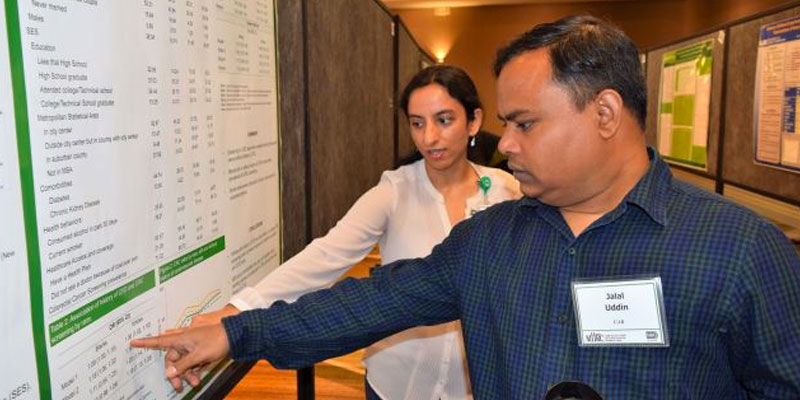“You’re in the belly of the beast now.”
That was the response of a Birmingham cab driver in welcoming author and health and social welfare policy expert Dr. Jonathan Engel to Birmingham. Engel, author of “Fat Nation: The history of obesity in the United States” spoke to about 65 health experts at UAB’s 14th annual Health Disparities Research Symposium.
Indeed, Engel’s mission was to spotlight the numerous health problems caused almost entirely by obesity. Alabama ranks No. 5 among the nation’s 10 fattest state populations.
“Overweight is highly correlated with type 2 diabetes, cancer, hypertension, arthritis and other health issues,” said Engel, a professor at Baruch College at the City University New York (CUNY). “Too much weight puts enormous stress on joints and on the heart. It’s a long-term, chronic strain on the body.”
Engel said more than 50 percent of meals are eaten outside the home, a huge departure from American norms as compared to the middle of the 20th century. Noting that he and his wife made concerted efforts to ensure their four children ate healthily, Engel said it’s much easier to control what you eat by cooking your own food and avoiding processed foods.
“My main message is the obesity epidemic is largely environmental,” Engel said. “We’ve created a food environment where it’s very difficult for anyone to be thin.”
Sponsored by UAB Minority Health & Health Disparities Research Center (MHRC), the symposium included oral presentations and poster sessions featuring original research by academic investigators, scholars and community partners in the fields of basic science, clinical research, social and behavioral science, and community-based research.
“Your environment has a huge aspect on your behavior and health,” said keynote speaker Dr. Karen Glanz. A member of the U.S. Task Force on Community Preventive Services for 10 years, Glanz’s research focuses on cancer prevention and control, theories of health behavior, obesity and the built environment, social and health policy, and new health communication technologies.
“We know that physical activity can prevent heart disease, cancer, depression and cognitive decrease across the life span,” said Glanz, director of UPenn Prevention Research Center at the University of Pennsylvania. “There are real disparities in areas of the South and Southeast, which fare less well in physical activity.”
Glanz recommends design changes and health policy intervention to influence urban design that incorporates sidewalks and parks; encourages land-use policies such as zoning that allows residents to be more active; increases access to public parks and outreach; and adds prompts and signs that encourage stair usage.
On April 18, UAB’s Dr. Mona Fouad took part in a roundtable discussion with Dr. Ben Carson, U.S. Secretary of Housing and Urban Development, and community leaders about creating a social services hub for five housing communities in greater Birmingham.
For nearly 30 years, MHRC Director Fouad has worked to reduce health disparities in vulnerable communities, whose troubles are compounded when located in food-imbalanced areas.
“Areas without grocery stores are more often found in underserved communities,” Fouad said in 2017, and are often created in part by residents’ lack of purchasing power and transportation to buy fresh fruits and vegetables.
Researchers share their findings
About 20 researchers shared their studies in breakout sessions: policy and system influences of health; disparities measurement and methods; and social and environmental determinants of health.
Brittney Davis, a postgraduate fellow in the UAB studying in the HudsonAlpha Genomic Medicine Training Program, dreams of doing research that will bring positive health outcomes for Alabamians. She discussed her findings diagrammed on a poster.
“I want to learn how to use pharmacogenetic data in making clinical decisions,” said Davis, who earned a bachelor’s degree in biology from UAB and her doctor of pharmacy degree from Samford University in 2018. “I have learned a great deal about how drugs work at the molecular level, and how they can be profoundly influenced by genetic factors.”
During a breakout session about clinical and social factors of excess hypertension risk, Dr. Suzanne Judd said diet definitely matters. The disparity for stroke is worse, at younger ages, for black Americans. Among 30,239 white and black participants, a high-fat and high-cholesterol diet was the most powerful risk factor for high blood pressure, stroke, heart disease, cancer and cognitive decline.
“There are reasons for geographic and racial differences in stroke; African Americans have more strokes,” Judd said.
“The Southern diet score is the most potent mediator of the black/white difference in hypertension risk, accounting for 51.5 percent of the excess in men and 25.8 percent in women. We can attribute the Southern diet as the biggest factor for hypertension and diabetes.”
Dr. Peng Xu discussed the mutational landscape of cancer patients with overweight and obese tendencies, whose findings were part of a cancer study led by Dr. Zechen Chong of the UAB School of Medicine.
“There’s a contribution of excess body weight to different cancer cases,” Xu said. “We found more endometrial cancer in obese patients and more somatic mutations of BMI in cancer patients. BMI was higher among the different cancer patients.”
Healthy diet, physical activity equal healthier future
Wallace said it’s important for everyone to know their health numbers, such as blood pressure and blood sugar readings, and cholesterol levels, and to take control of their diet and increase physical activity.
“We need to do these things before the person presents at the ER with high blood pressure,” she said. “Our state is called ‘Alabama the Beautiful,’ but Alabama can also be healthy, Alabama can be well.”
Decreasing health disparities in Alabama
UAB MHRC has a track record of improving areas where residents live, work and play through policy systems and environmental changes. Sometimes, the barriers seem nearly insurmountable, said Dr. Theresa Wallace.
“About 20 years ago, lots of emphasis was placed on the individual and their choices, but we know and appreciate that individuals live in a larger context,” said Wallace, program director for UAB Preventive Medicine. “The determinants of health include many things. We look at the context of where health happens – at home, school and work.”
She said physical activity, eating healthy, and prevention and wellness are the three pillars of good health. Those tenets are the building blocks of UAB’s “Healthy Alabama 2030: Live HealthSmart” Grand Challenge, in partnership with 90 state and federal agencies and groups.
She believes the program has the makings to propel Alabama from the bottom of national health rankings to the top.
“It takes partnership and everyone being at the table for the collective good of the community,” said Wallace. “Right now, our state is always at the bottom, 48th or 49th, and that’s just unacceptable. It’s time to change our trajectory through our policy systems and improvements. Our goal is to put Alabama at the top, healthwise.”
Courtesy of Alabama Newscenter













